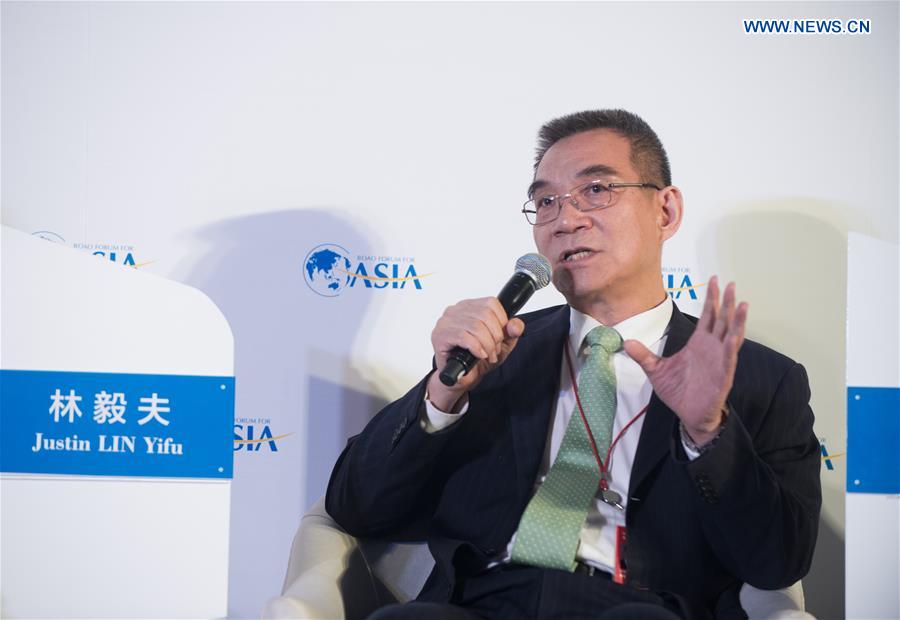Achieving 6.5-pct growth 'well within China's reach'
Updated: 2016-03-26 17:07
(Xinhua)
|
|||||||||
 |
|
Economist Justin Lin Yifu speaks at the session "Dialogue of Asian Civilizations" during the Boao Forum for Asia (BFA) Annual Conference 2016 in Boao, south China's Hainan Province, March 23, 2016. [Photo/Xinhua] |
BEIJING -- The continuous slowdown of China's economy does not mean the country will be unable to reach its target of maintaining an at least 6.5-percent growth during the next five years, a former World Bank chief economist said in a newly published commentary.
In its recently adopted 13th Five-Year Plan, Beijing pledged to double its gross domestic product (GDP) and average rural and urban household incomes from the 2010 levels, which entails an average annual growth rate of at least 6.5 percent during the next five years.
The required minimum pace, albeit significantly slower than the 9.7 percent China has averaged since 1979, is undeniably fast by international standards. It is also only 0.4 percentage point lower than the 6.9 percent China scored last year.
Some pessimists, citing China's economic deceleration since 2010 as well as South Korea's and Japan's growth records, have expressed doubt over whether the 6.5-percent target is feasible.
"I believe that it is," Lin Yifu, who also served as senior vice president of the World Bank, said unequivocally in an opinion piece posted Friday on the website of Project Syndicate, an international association of 404 newspapers across the world.
The question for China, after 36 years of catching up, is how much longer it can continue to benefit from the latecomer's advantage, he explained.
Some scholars believe China has reached its limits. Using historical data compiled by late economic historian Angus Maddison, they noted that the East Asian economies of Japan, South Korea and Hong Kong all decelerated after their per capita GDP reached about 11,000 US dollars in purchasing-power-parity terms relative to constant 1990 US dollar prices. In the five years after reaching that level, Japan saw its growth rate down to 3.6 percent, South Korea 4.8 percent and Hong Kong 5.8 percent.
As China is projected to cross the same threshold sometime this year, those pessimists have claimed that its average annual growth over the next five years will fall well below 7 percent.
"I disagree," said Lin, who is now honorary dean and professor with the National School of Development at Peking University. "What this analysis fails to take into account is the fact that advanced countries are not sitting by idly; they are growing and making technological breakthroughs. And that creates opportunities for developing countries to continue to learn."
"The best indicator of China's growth potential is not its per capita GDP relative to some arbitrary threshold; it is the difference in per capita GDP between China and the United States, the world's most advanced economy," he said. "And on this measure, China has plenty of room for expansion."
"When Japan crossed the 11,000-dollar threshold in 1972, its per capita GDP was 72 percent of the US level. When Taiwan crossed it in 1992, its per capita GDP was 48 percent of America's. The comparable figure for China today is only about 30 percent," he said.
A better model to estimate China's growth potential is to examine how other East Asian economies performed when they were at a similar point relative to the US level, he said.
In 2008, the last year for which Maddison provided figures, China's per capita GDP was 21 percent of the US level. Japan reached that level in 1951, and in the following 20 years it grew at an average rate of 9.2 percent. For Singapore, the year was 1967 and the pace in the next two decades was 8.6 percent. Taiwan, Hong Kong and South Korea kept growing at around 8 percent.
"There is no reason not to believe that China has the potential to do the same until 2018," he said, adding that "the Chinese economy's current slowdown is the result of external and cyclical factors, not some natural limit."
While the external drag is likely to continue as much of the developed world risks lost decades, China enjoys strong prospects in consumption and investment, on which it will have to rely to achieve its growth targets.
"Unlike developed countries, which often struggle to find productive investment opportunities, China can pursue improvements in infrastructure, urbanization efforts, environmental management, and high-tech industries," he said.
"And, unlike many of its developing-country rivals, China has ample fiscal space, household savings, and foreign-exchange reserves for such investments. The investments will generate jobs, household income, and consumption," he added.
As a result, even if external conditions do not improve, it is "well within China's reach" to maintain an annual growth of at least 6.5 percent, Lin said.
"In that case, the country will continue to be the world's primary economic engine, contributing about 30 percent of global growth until at least 2020," he said.
Today's Top News
President optimistic for Sino-German cooperation
Info sharing 'is key' as Europe faces terror threat
Uneasy times as Belgium mourns the dead
Belgian bombing suspect still at large: Prosecutor
Belgian media withdraws reports of suspect's arrest
Brussels bombers were brothers El Bakraoui
Chinese citizens in Belgium get help after attack
Europe ramps up security in wake of Brussels attacks
Hot Topics
Lunar probe , China growth forecasts, Emission rules get tougher, China seen through 'colored lens', International board,
Editor's Picks

|

|

|

|

|

|






